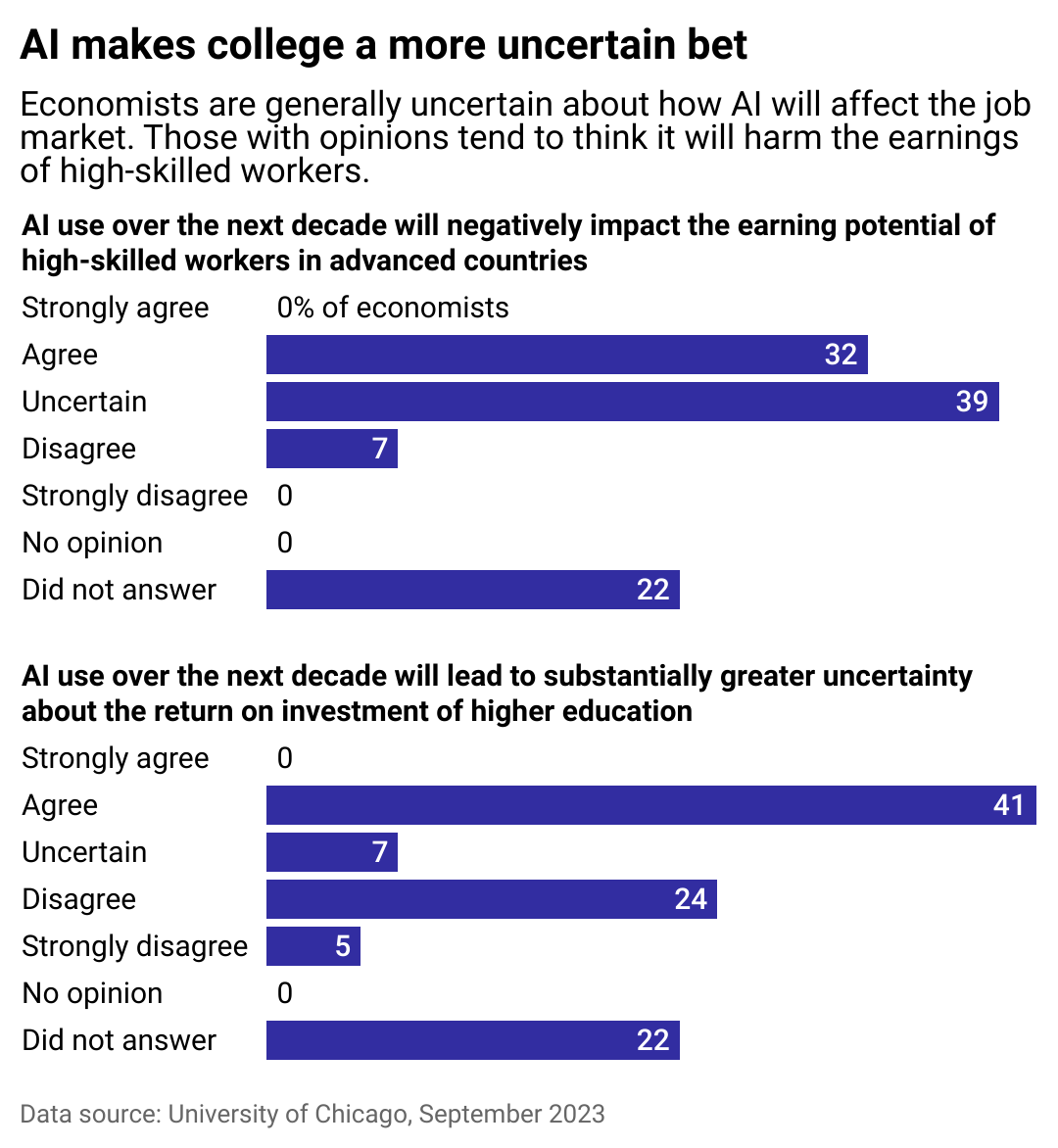
How high schoolers can plan for post-college career paths in the age of AI
This story originally appeared on HeyTutor and was produced and distributed in partnership with Stacker Studio.
How high schoolers can plan for post-college career paths in the age of AI
For the past few decades, the clearest path to a comfortable middle-class career in America has been through college. Research shows individuals with degrees earn more on average than those without one.
Even as wage premiums for those who earned college degrees have decreased slightly since the COVID-19 pandemic, in the 21st century, individuals with a degree earned 68% to 79% higher average wages than those with a high school diploma, research from the Federal Reserve Bank of San Francisco showed.
While college graduates have benefited from technological progress and globalization during this time, the recent rise of generative artificial intelligence technologies has already come at a cost for white-collar workers in some automation-prone areas of work, according to a paper from Harvard University and colleagues from the German Institute for Economic Research and the Imperial College Business School.
Just eight months after the introduction of ChatGPT, job postings related to writing and coding saw a 21% decrease compared to other jobs requiring more manually intensive skills. The paper found that graphic design and other jobs related to making images also saw a 17% decrease in demand compared to other manually intensive jobs.
With post-college career paths no longer as obvious, HeyTutor examined academic research and expert opinions to see how high schoolers can prepare for a world where AI is everywhere.

Old fears when it comes to new technologies
Although uncertainty surrounds the future of generative AI, a Chicago Booth poll of U.S. economists showed some had concerns about the technology's negative impact on high-skilled workers.
Of the panelists, 32% agreed AI use over the next decade will negatively impact the earning potential of a sizable number of high-skilled workers in advanced countries, while about 2 in 5 (39%) respondents were uncertain of AI's impact.
However, this sentiment in the face of the latest technology isn't new. From the spinning jenny and cotton gin during the Industrial Revolution to more modern advancements in technology like online shopping, productivity streamlining has always posed career stability concerns for skilled laborers—much like the issues being aired now with the rise of AI.
More than 200 years ago, Luddites in England focused their efforts on destroying machines of manufacturers who used them in a "deceitful" manner that was against the standard labor practices of the time, according to Smithsonian magazine. Luddites were not against machines, however, but wanted them run by workers who were properly trained and compensated.
More recently, advancements in automation tools like robots and AI have replaced workers performing routine tasks, as the research from Harvard University, the German Institute for Economic Research, and the Imperial College Business School shows. While hundreds of studies have been conducted on how work will change in the future, none have proven conclusive. Change is happening, though, and McKinsey predicts that, within the decade, generative AI technology will be capable of median human-level performance in tasks like coordination and understanding language.
The 21st century also has already seen the emergence of the gig economy used by companies like Uber and DoorDash, which rely on paying drivers little money while maintaining a largely automated "white-collar" management workforce, with algorithms making decisions on how to coordinate a network of drivers, said Brian Dolber, associate professor of communication at California State University, San Marcos, and co-editor of "The Gig Economy: Workers and Media in the Age of Convergence."
"Unless we work to curtail the impact of AI on our economy, historians may see the gig economy as an origin point for the transformations in labor and technology," Dolber told Stacker. "I think the difference [between AI and] current algorithmic management, though, may be the former's ability not just to coordinate production but to synthesize input such that it can produce new ideas."

Preparing for an uncertain future
Several major technology companies have announced layoffs in 2024, with some, including Dell and Cisco, citing AI as a critical part of their strategy to compensate for the loss of thousands of employees.
While Dolber said it is not uncommon for employers to use technological change as a rationale for downsizing, reductions in the workforce can create anxiety about getting into college, selecting the right major, and entering the right line of work.
"Having a historical perspective and understanding that we have been through massive technological and economic change before—and that society as a whole will shape how that process unfolds again—can keep us from panicking and feeling like we have no power," Dolber said.
So what should a student trying to anticipate the future of the job market do?
It is difficult to speak in specifics, but Dolber championed pursuing a quality education that teaches what AI continues to fall short on: critical thinking and ethical reasoning. Dolber says those skills are "going to be necessary not just to keep one step ahead of the robots but to shape what our world looks like when there is so much contingency and instability."
Hone the skills that machines strive to replicate, noted a Harvard Business Review article co-written by noted business thinker Dorie Clark and Tomas Chamorro-Premuzic, author of "I, Human: AI, Automation, and the Quest to Reclaim What Makes Us Unique." The authors noted that AI responses only rely on text prediction and not true human experience. The essential question a student must ask while learning is, "What can I do that a robot can't?"
Apart from developing skill sets outside of AI's capabilities, Dolber still recommends understanding these new tools. "It's part of being literate in the 21st century," he said. Using these new tools and approaching them with an open mind can help a young student better incorporate them into their arsenal when it comes time to enter the workforce.
Finally, the Harvard Business Review recommends undertaking real-world tasks. "It's essential to recognize that one thing AI can't disrupt is our analog, in-person connections with others," the article noted. For a prospective professional, this means cultivating real-life relationships through meetings, meals, attending conferences, and striking up conversations. These connections will eventually become competitive differentiators in a crowded marketplace.
Story editing by Carren Jao. Additional editing by Kelly Glass. Copy editing by Paris Close. Photo selection by Ania Antecka.



